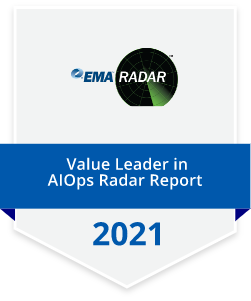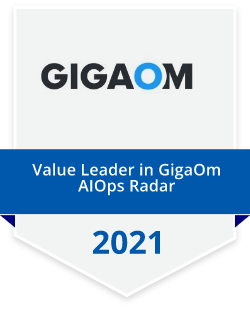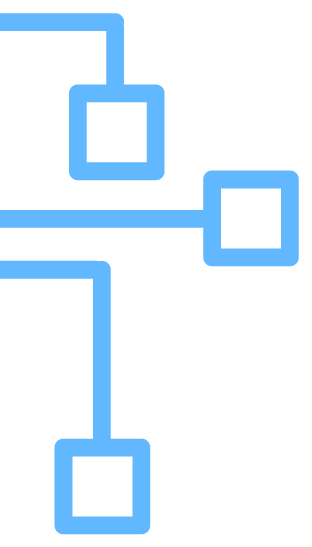Let us know how we can help
Sales & Pricing
Speak to a rep about your business needs
Help & Support
See our product support options
General inquiries and locations
Contact UsWhat does AIOps mean? AIOps explained
Learn how AIOps streamlines ITOps and service delivery using artificial intelligence
AIOps helps find and fix business application problems with capabilities ranging from advanced probable cause analysis to intelligent automation. Read on to learn more about how AIOps works and why it's a critical topic for today's modern IT organization.
What is AIOps?
AIOps stands for "artificial intelligence for ITOps." It's an approach designed to manage the complexities of modern IT environments.
By employing a combination of machine learning (ML), predictive analytics, and artificial intelligence, AIOps platforms automate and improve ITOps. They optimize service availability and delivery across diverse and intricate IT systems.
The digital age demands transformation, and AIOps has become crucial for all business sectors. Today's IT landscapes are complex, blending cloud services, traditional on-premises infrastructure, and a myriad of applications.
Ensuring consistent service and performance amidst this complexity is a significant challenge. AIOps meets this challenge head-on with its advanced tech layer. It sorts through vast amounts of data, highlights critical issues, streamlines everyday tasks, and anticipates future problems to avoid system downtimes.
Industries across the board depend on AIOps for seamless operational continuity. For example:
- Financial sectors use AIOps for high-speed transactions and immediate fraud detection.
- Healthcare relies on it for critical patient data management and system uptime.
- Retail experiences gains from improved online customer experiences and platform performance.
- Manufacturing sectors use it to monitor supply chain activities.
- Telecommunications depend on AIOps to maintain extensive network services and customer connectivity.
AIOps is integral to industries aiming to revamp ITOps, cut costs, and root out inefficiencies. It's not merely about operational uptime; it creates a smart IT ecosystem that's responsive and anticipative. AIOps prepares businesses to tackle current demands and future challenges.
At the heart of AIOps is the utilization of big data. It draws on extensive IT operational data to:
- Enhance traditional analytics.
- Instantly identify and address issues as they arise.
- Offer proactive alerts about potential future issues, preventing them from escalating.
By making ITOps smarter, AIOps provides a substantial edge to businesses, making their IT environments not just operational, but strategically foresighted.
AIOps is a full-scale solution to support complex enterprise ITOps. Other names for AIOps include AI operations and AI for ITOps. Gartner, a leading analyst firm, coined the concept of AIOps in 2017 with this definition:
"AIOps combines big data and machine learning (ML) to automate ITOps processes, including event correlation, anomaly detection and causality determination."
GartnerDrivers and goals
ITOps face two significant challenges today:
- Complexity and hybrid environments: Businesses operate within intricate IT landscapes, including cloud services, private data centers, and mainframes. These elements must communicate effectively, often across different locations.
- New technology integration: Companies regularly integrate new technologies to meet evolving employee and customer expectations.
These challenges can lead to issues like limited visibility, diminished performance, and a proliferation of costly tools. AIOps presents a solution by transitioning businesses from a reactive to a proactive operational approach.
Solutions deployed using AIOps include:
- Intelligent automation: AIOps enhances ITOps by automating mundane tasks. This automation frees IT personnel from the drudgery of manual management and constant issue resolution.
- Predictive insights: By foreseeing IT problems, AIOps allows teams to focus on innovation and strategic initiatives, thereby improving productivity.
AIOps gives IT teams the ability to distinguish critical issues from minor ones. It utilizes advanced analytics and machine learning (ML) to filter out irrelevant alerts, focusing on incidents that could disrupt business.
The strategic benefits are:
- Streamlining operations: AIOps consolidates operational data into a comprehensive platform, offering diverse analytical views.
- Real-time issue management: It employs analytics and AI/ML to detect and respond to IT issues as they occur, promoting swift resolution and reporting.
Overall, AIOps serves as a catalyst, enhancing the efficiency and focus of IT management. It ensures that resources are allocated smartly, and IT efforts significantly benefit the organization's goals.
AIOps benefits
The key AIOps benefits include a substantial reduction in the noise of events IT teams must manage daily. By automating remediation processes, AIOps enables faster mean time to repair (MTTR), significantly reducing the impact of IT incidents on business operations. The automation of remediation tasks, often referred to as auto-remediation, streamlines IT processes and enhances the efficiency and responsiveness of IT services.
-
Reduce event noise
AIOps platforms use sophisticated algorithms to sift through the noise, identifying and prioritizing incidents that require attention. This improves the signal-to-noise ratio, allowing IT teams to concentrate on high-impact problems and respond more effectively to incidents.
-
Reduce MTTR
By accelerating the identification and resolution of IT incidents, AIOps significantly reduces the average time to repair. This minimizes downtime and ensures critical business applications remain up and running.
-
Automated remediation
Automating remediation, or "auto remediation," means that AIOps can not only identify problems but also take corrective action without human intervention. This proactive approach is crucial for maintaining continuous service availability and performance.
-
Cost reduction
By optimizing IT operations, AIOps helps organizations reduce operational costs. This includes minimizing the waste of resources and improving the utilization of existing infrastructure.
-
Increased productivity
The implementation of AIOps drives higher productivity within IT teams. By automating routine tasks and providing actionable insights, IT professionals can focus on strategic initiatives that add more value to the business.
How AIOps works
Many AIOps solutions provide piecemeal intelligence and automation capabilities. But the pace of business today demands a comprehensive, enterprise-wide solution that can capitalize on valuable data and prevent problems before they occur.
Enterprise AIOps solutions should coordinate multiple functions to optimize operations, including:
-
Ingestion
Ingesting, indexing, and normalizing events and data from all types of sources—networks, domains, infrastructure, applications, and more—across an increasingly hybrid infrastructure. Ingestion should support both real-time (streaming) and historical data analysis
-
Discovery and unified topology
Discovering IT assets and assembling a unified topology, no matter the source. The topology indicates key information, such as proximity and logical dependencies, so the AIOps platform can understand how assets support the services a business delivers.
-
Correlation
Compressing and correlating events—connecting topology and time to related events—in order to reduce human intervention.
-
Recognition
Processing data from events and telemetry in order to detect or predict important incidents, events, or other anomalous behavior. Here, machine learning helps the AIOps solution to continually learn and improve its understanding of individual event patterns.
-
Remediation
Building on all the previous functions to fix or otherwise handle anomalous events and behaviors. An effective AIOps solution can remediate in two ways—by observing and responding automatically and by taking explicit direction.

Why AIOps: Use cases for AIOps
What can AIOps offer a business? With AIOps, businesses can navigate the complexities of modern IT landscapes with greater precision and foresight.
With the integration of artificial intelligence into ITOps, AIOps offers a suite of capabilities that not only predicts and prevents IT issues but also optimizes the performance and efficiency of IT services.
From real-time analytics to intelligent automation, AIOps is redefining how IT departments across industries—from finance to healthcare, retail to manufacturing—proactively manage their operations, ensuring resilience, enhancing service delivery, and driving business growth.
The application of AI in ITOps has led to several compelling use cases that showcase its ability to enhance operational efficiency and preemptively resolve IT issues.
Here are the most common use cases of AIOps:
Open, cross-domain engagement, observability, and actionability. With true enterprise-wide, platform-driven management, IT can better predict issues, resolve them faster, and provide always-on service.
Event noise reduction. Separate the high-impact problems from common spikes to get a clearer view of the real issues causing event storms.
Intelligent anomaly detection. By federating data from the entire IT environment, including third-party tools, AIOps can filter and correlate the data to trigger appropriate events and notifications.
Intelligent automation and event management. With continuous detection of the state of infrastructure and service desk activity, users can take or recommend automated actions to fix issues faster.
Cross-domain situational understanding and probable cause analysis. Apply advanced analytics to aggregated data across infrastructure and applications to isolate issues and respond, saving time and resources.
Capacity analytics. Understand when and how resources are being used, determine the resources needed to support the most in-demand apps and services, and identify idle and unused resources that are opportunities for efficiency improvements and cost reduction.
BMC approach to enterprise AIOps
At BMC, we believe that AI can augment human effort—and AIOps is a perfect example. Reducing manual work, AIOps helps employees focus on value-add activities that require human skills.
Our AIOps approach enables your organization to make better decisions, faster. Find and fix problems before you’re aware of them. Focus on doing what’s important for your business, whether it’s building cars, running communications networks, maintaining client financial security, or delivering healthcare.
As a leader in enterprise IT solutions for more than four decades, we’re uniquely prepared to help our customers implement enterprise-wide AIOps—from cloud to data center to mainframe, and everywhere in between. With solutions like BMC Helix and BMC AMI, you can reduce problems, find fixes faster, and deliver service at the speed and quality that your users expect.
BMC is a trusted leader in AIOps





We’ll help you run your business as you reinvent it

We know you have a lot to juggle, so we’ll get back to you as soon as possible. The more you can tell us about your unique business needs, the faster we can guide you to the right solution.
Whether you’re in the early stages of product research, evaluating competitive solutions, or just trying to scope your needs to begin a project, we’re ready to help you get the information you need.
BMC has helped many of the world’s largest businesses automate and optimize their IT environments. Let’s put that experience to work for your organization.
Helpful Resources about AIOps
- A Day in the Life with AIOps
- Categories: AIOpsops
- BMC Automated Mainframe Intelligence (BMC AMI)
- Artificial Intelligence (AI) vs Machine Learning (ML): What’s The Difference?
- AIOps: Artificial Intelligence for IT Operations
- Key Insights and Takeaways from the 2022 Gartner Market Guide for AIOps Platforms

